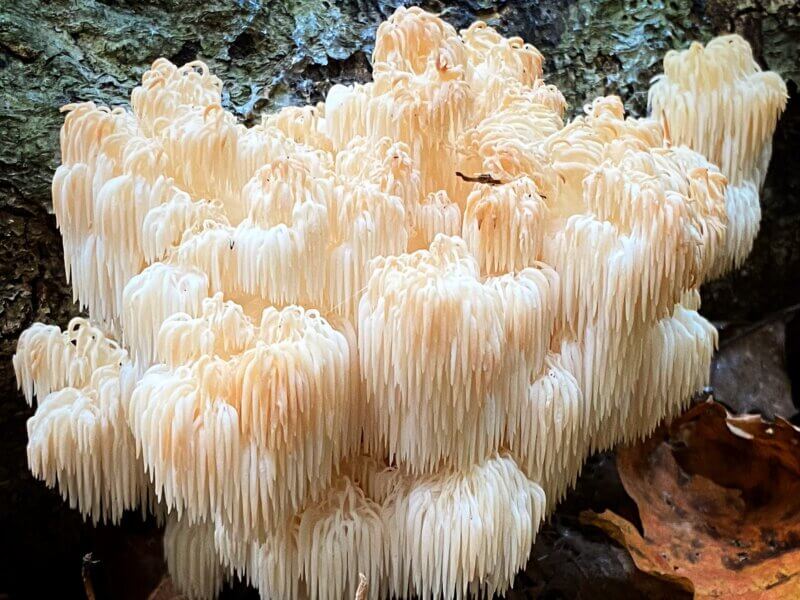Kids pitch bear’s head tooth as Vermont’s state mushroom
Feeling cooped up after incessant Zoom meetings during the COVID pandemic, Rep. Michelle Bos-Lun, D-Westminster, started going on woodland walks with her dog. The more time she spent outside, the more she noticed an evolving cast of characters on her route: mushrooms.
“There would be all these different amazing mushrooms emerging, and the change was really quick and really dramatic,” Bos-Lun said in an interview. “There were so many different colors and styles: some of them edible, some of them poisonous and literally some that had gold sparkles on them.”
Bos-Lun regularly visits public schools to teach students about the legislative system. In the past, she simulated the process by having kids vote for a Vermont state ice cream.
“I remember thinking when it was done, ‘You know what? I wish that I could actually generate some ideas with the kids and let them see the next part of the process,’” Bos-Lun said. “And so, the first thing that came to mind, because I happen to love mushrooms, is: ‘Do we have a state mushroom?’ And I actually didn’t know. When I looked it up and realized that we didn’t, that five other states do, that four other states have them pending, I was like, ‘That’s it.’”

H.664, introduced by Bos-Lun in the House agriculture committee and sponsored by a dozen other lawmakers, nominates Hericium americanum as Vermont’s state mushroom. The spindly Hericium americanum was handpicked by the state’s toughest critics: kids.
Students from two schools Bos-Lun is familiar with, Windham Elementary School and Compass Middle School, were tasked with selecting the perfect mushroom. After much debate, they landed on Hericium americanum, commonly called bear’s head tooth.
“We think the bear’s head tooth mushroom should be the state mushroom because it can be used as medicine, it can be found locally, it is in the mushroom family Hericium americanum which means ‘hedgehog of the Americas,” Charlie Pelton, Windham Elementary student, told committee members March 12. His brother, George, sat beside him, controlling a set of presentation slides.
Nicholas Duprey, a seventh grade student at Compass Middle School, further explained the medicinal qualities of the fungus during his testimony.
“Bear’s head tooth is known as a ‘brain food.’ It is also very nutritious,” he said at the same meeting. “Bear’s head tooth are effective against memory loss, depression, anxiety, dementia, neurological disorders and cancer. As stated above, it also has wound-healing properties. Usually, they are taken as a tincture, which are like eye drops, or a powder.”
Duprey assured committee members bear’s head tooth have no poisonous doppelgängers. Even if a Vermonter foraged the wrong fungus, they wouldn’t be in danger.
“Although this mushroom looks similar to some others, none in this group are toxic if you mistake them with each other,” he said.
One of Duprey’s classmates, Zinth Mae Holder, said the mushroom’s white, spiny appearance makes it a wonderful candidate for another reason.
The mushroom “represents the icicles and waterfalls we have here,” they said, explaining that its spiky hanging clusters mimic Vermont’s winter landscape.

The kids picked an excellent nominee — so say mushroom experts.
Meg Madden, a Vermont-based photographer and myco-educator who runs a popular mushroom-focused Instagram, thinks bear’s head tooth is a great representative for the state. She explained the “native Vermonter” is always the showstopper on hikes she guides.
“When I find it and show people, their minds are blown,” she told Community News Service. “They can’t believe that, first of all, it’s a mushroom because it breaks the preconceived notion of what a mushroom looks like — it doesn’t have a cap, it doesn’t have a stem, it doesn’t have gills. … It looks kind of like a pom-pom having a crazy hair day.”
Madden said the mushroom is not only a beautiful fungus to look at, but also one that can be cultivated, cooked and sold locally. She said there’s great economic potential to create and sell local products with the state’s mushroom. And she can confirm its deliciousness.
“My favorite thing to do with it is to make bear’s head tooth crab cakes,” she said. “It’s so much like crab meat, texture-wise and flavor-wise. I think if you served them to someone and they didn’t know it was mushrooms, then they wouldn’t even know.”
Lydia Joy Dutton, a fifth grader from Windham Elementary, is also excited about growing a state mushroom. Feeling shy in front of committee members, Dutton had Bos-Lun read parts of her testimony for her. In her presentation, Dutton wrote that a state mushroom would be a fun horticultural opportunity for her family.
“My family have farmed in Vermont since the late 1700s,” the student wrote. “We have farm stands in Manchester, Newfane and Brattleboro. We sometimes sell mushrooms. I hope we sell bear’s head tooth one day.”
(The Community News Service is a program in which University of Vermont students work with professional editors to provide content for local news outlets at no cost.)
